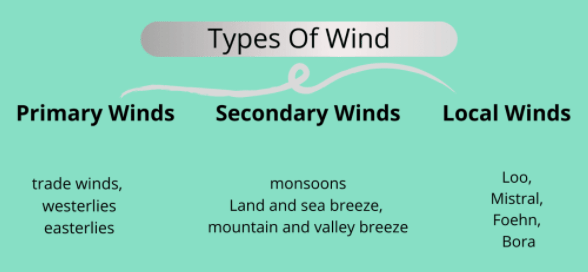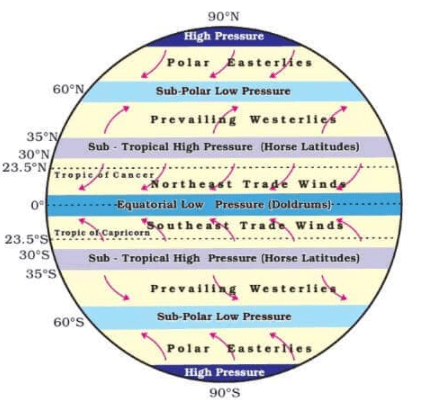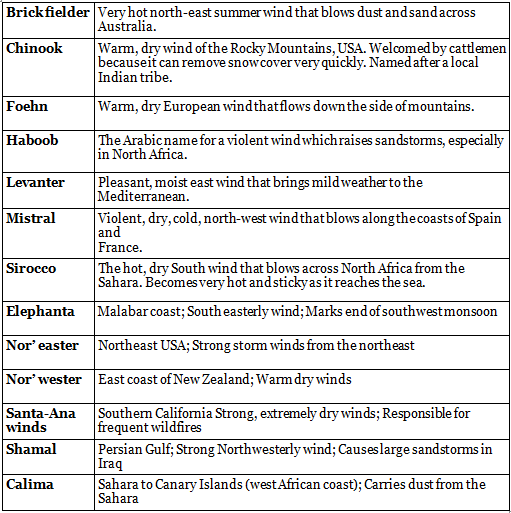Planetary & Local Winds | Geography Optional for UPSC PDF Download
| Table of contents |

|
| Wind |

|
| Primary Winds or Prevailing Winds or Permanent Winds |

|
| Secondary Winds or Periodic Winds |

|
| Frequently Asked Questions (FAQs) of Planetary & Local Winds |

|
Wind
Wind can be simply defined as the horizontal movement of air. This movement occurs due to variations in air pressure within our atmosphere. Air under high pressure tends to flow towards areas of low pressure. In this article, we will explore the various types of wind.

Types of Wind

Primary Winds, also known as Permanent, Prevailing, or Planetary Winds
These winds include the trade winds, westerlies, and easterlies, and they consistently blow in the same direction across the globe.
Secondary or Periodic Winds
- Seasonal winds: These winds shift their direction based on the season. A notable example is the monsoon winds in India, which change direction in different seasons.
- Periodic winds: These winds occur periodically, such as the land and sea breezes, as well as the mountain and valley breezes. Their occurrence depends on specific conditions like temperature and pressure differences.
Local Winds
Local winds are specific to certain regions and typically blow during particular times of the day or year. Examples of local winds include the Loo, Mistral, Foehn, and Bora. These winds are influenced by local geographical features and weather patterns.
Primary Winds or Prevailing Winds or Permanent Winds
- These are the planetary winds which blow extensively over continents and oceans.
- The two most well- understood and significant winds for climate and human activities are trade winds and westerly winds.
Trade Winds
- The trade winds are winds that blow from the sub-tropical high-pressure zones towards the equatorial low-pressure belt, occurring between 30°N and 30°S across the Earth's surface. In the northern hemisphere, they are known as the north-eastern trade winds, while in the southern hemisphere, they are called the south-eastern trade winds. These winds were named "trade winds" due to their consistent and regular direction, which aided sea merchants in navigating their ships.
- The deflection of the trade winds from their expected north-south direction can be explained by the Coriolis force and Farrel's law. According to this law, trade winds in the northern hemisphere are deflected to the right, while those in the southern hemisphere are deflected to the left.
- At their origin in the sub-tropical high-pressure belt, trade winds are descending and stable. As they move towards the equator, they become warmer and more humid, picking up moisture along the way. When the trade winds from both hemispheres converge at the equator, they rise and produce heavy rainfall due to this convergence.
- The eastern parts of the trade winds, which are associated with cool ocean currents, tend to be drier and more stable than the western parts of the ocean. Overall, the trade winds play a significant role in global weather patterns and have been historically important for navigation and trade.
 Major Pressure Belts & Wind System
Major Pressure Belts & Wind System
Westerlies
- The westerlies are winds that blow from the subtropical high-pressure belts (located at 30°-35° latitude) towards the sub-polar low-pressure belts (located at 60°-65° latitude) in both the northern and southern hemispheres. In the northern hemisphere, these winds blow from the southwest to the northeast, while in the southern hemisphere, they blow from the northwest to the southeast.
- The southern hemisphere's westerlies are more powerful and consistent, largely due to the vast expanse of water in that region. In contrast, the northern hemisphere's westerlies are less regular due to the uneven distribution of large landmasses. As a result, the westerlies in the northern hemisphere are less effective during the summer and more vigorous during the winter.
- The westerlies are responsible for bringing significant precipitation to the western parts of continents, such as the northwest coasts of Europe. This is because they collect moisture as they pass over the oceans. In the southern hemisphere, the westerlies become even more forceful due to the lack of land and dominance of the oceans. Their speed increases as they move southward, often resulting in stormy, gale-force winds.
- The westerlies are most prominent between 40° and 65°S latitudes, which are often referred to as the Roaring Forties, Furious Fifties, and Shrieking Sixties – terms that strike fear into the hearts of sailors. The poleward boundary of the westerlies is subject to significant fluctuations, both seasonally and in the short term. These winds are responsible for creating wet weather and variable conditions.
Polar easterlies
- The Polar easterlies are dry and cold winds that predominantly blow from the north-east to the south-west direction in the Northern Hemisphere, and from the south-east to the north-west direction in the Southern Hemisphere.
- These winds originate from the high-pressure polar regions and move towards the lower pressure sub-polar areas.
Secondary Winds or Periodic Winds
- These winds change their direction with change in season.
- Monsoons are the best example of large-scale modification of the planetary wind system.
- Other examples of periodic winds include land and sea breeze, mountain and valley breeze, cyclones and anticyclones, and air masses.
Monsoons
- Monsoons are large-scale weather patterns characterized by a seasonal reversal of wind direction. They were traditionally understood as land and sea breezes on a grand scale, resulting in convectional circulation.
- During the summer season, the southern hemisphere's trade winds are drawn northwards due to the sun's apparent northward movement and the presence of an intense low-pressure core in the northwestern region of the Indian subcontinent. As these winds cross the equator, the Coriolis force deflects them to the right, causing them to approach the Asian landmass as southwest monsoons. Since these winds travel a long distance across a vast expanse of water, they become saturated with moisture by the time they reach India's southwestern coast, resulting in heavy rainfall in India and neighboring countries.
- In contrast, during the winter season, a high-pressure core forms to the north of the Indian subcontinent, generating divergent winds that travel southwards towards the equator. This movement is reinforced by the sun's apparent southward movement. These northeast or winter monsoons cause some precipitation along the east coast of India.
- Monsoon winds affect regions such as India, Pakistan, Bangladesh, Myanmar (Burma), Sri Lanka, the Arabian Sea, the Bay of Bengal, Southeast Asia, Northern Australia, and China. In eastern Asian countries like China and Japan, the winter monsoon is more powerful than the summer monsoon. More information about monsoons will be covered in the study of Indian climate.
Land Breeze and Sea Breeze
- Land and sea breezes are phenomena that occur due to the different ways in which land and sea absorb and release heat. During the daytime, the land heats up more quickly and becomes warmer than the sea. As a result, the air above the land rises, creating a low-pressure area, while the cooler sea has a relatively high-pressure area. This pressure difference causes the wind to blow from the sea toward the land, creating a sea breeze.
- Conversely, at night, the situation is reversed. The land cools down more rapidly than the sea, making it cooler in comparison. This leads to a pressure gradient from the land to the sea, and as a result, the wind blows from the land towards the sea, creating a land breeze.
Valley Breeze and Mountain Breeze
- In areas with mountains, the air circulation patterns differ from those in flat regions. During the day, the sun heats the mountain slopes, causing the air to rise and creating an upward movement of air known as an upslope wind. To fill the empty space left behind, air from the valley flows upwards, creating a wind called the valley breeze.
- At night, the situation reverses. The mountain slopes cool down, causing the air to become denser and descend into the valley. This downward movement of air is called mountain wind or katabatic wind. It consists of cold air from high plateaus and ice fields flowing into the valley.
- Another type of katabatic wind can be found on the side of the mountain range that is sheltered from the wind, known as the leeward side. As these winds cross the mountain range, their moisture condenses and precipitates. When the now-dry air descends the leeward slope, it warms up through a process called adiabatic heating. This warm, dry air can cause snow to melt rapidly.
Tertiary Winds or Local Winds
- Local differences in temperature and pressure produce local winds.
- Such winds are local in extent and are confined to the lowest levels of the troposphere. Some examples of local winds are discussed below.
Loo
- Harmful Wind
- In the plains of northern India and Pakistan, sometimes a very hot and dry wind blows from the west in the months of May and June, usually in the afternoons. It is known as Its temperature invariably ranges between 45°C and 50°C. It may cause sunstroke to people.
Foehn or Fohn
- Foehn, also known as Fohn, is a type of local wind that occurs in the Alps. This wind is characterized by its strong, gusty, dry, and warm nature, which is a result of its formation on the leeward side of a mountain range.
- As the windward side of the mountain absorbs moisture through orographic precipitation, the air that descends on the leeward side becomes warm and dry, forming the Foehn wind. This wind typically has a temperature ranging from 15°C to 20°C.
- The Foehn wind offers several benefits to the local environment, such as melting snow to provide grazing areas for animals and aiding in the ripening of grapes. Overall, this unique wind plays a significant role in the climate and ecology of the Alpine region.
Chinook
- Beneficial Wind
- Foehn like winds in USA and Canada move down the west slopes of the Rockies and are known as
- It is beneficial to ranchers east of the Rockies as it keeps the grasslands clear of snow during much of the winter.
Mistral
- Harmful Wind
- Mistral is one of the local names given to such winds that blow from the Alps over France towards the Mediterranean Sea.
- It is channeled through the Rhine valley. It is very cold and dry with a high speed.
- It brings blizzards into southern France.
Sirocco
- The Sirocco is a powerful wind originating from the Mediterranean region, specifically from the Sahara Desert, that can reach hurricane-level speeds in North Africa and Southern Europe. This wind is formed when a warm, dry, tropical air mass is drawn northward by low-pressure cells moving eastward across the Mediterranean Sea. The source of the Sirocco lies in the Arabian or Sahara deserts.
- When the hot, dry continental air comes into contact with the cooler, wetter air of a maritime cyclone, the two air masses mix. The low-pressure system's counter-clockwise circulation then pushes this mixed air towards the southern coasts of Europe.
- As a result, the Sirocco brings about various weather conditions, such as dry and dusty conditions along the northern African coast, storms within the Mediterranean Sea, and cool, wet weather throughout Europe.
Table of Major Local Wind Systems

How is Wind Measured?
The wind has speed as well as direction, to measure this parameter, two different devices are used- Anemometers
- Wind vanes
Anemometers: is used for measuring the speed of the wind.
Wind vanes: is used for determining the direction of the wind.
Causes of Wind
The main cause of generation of wind is the uneven heating of two regions.Examples
- Uneven heating between land and sea
- Uneven heating between equator and pole
Conclusion
Wind can be simply defined as the horizontal movement of air due to variations in air pressure within our atmosphere. There are various types of winds, including primary winds (such as trade winds and westerlies), secondary winds (like monsoons and land/sea breezes), and local winds (such as Loo, Mistral, Foehn, and Bora). These winds play a significant role in shaping global weather patterns and climate, as well as impacting human activities like navigation and trade. The measurement of wind involves anemometers for speed and wind vanes for direction, and the primary cause of wind generation is the uneven heating of different regions.Frequently Asked Questions (FAQs) of Planetary & Local Winds
What are the primary factors that cause wind?
The main factors that cause wind are uneven heating of the Earth's surface, which leads to variations in air pressure within the atmosphere. Air under high pressure tends to flow towards areas of low pressure, resulting in the movement of air known as wind.
What are the differences between primary, secondary, and tertiary winds?
Primary winds, also known as permanent, prevailing, or planetary winds, are consistent winds that blow in the same direction across the globe, such as trade winds, westerlies, and easterlies. Secondary winds, or periodic winds, change their direction based on specific conditions, like temperature and pressure differences, or seasons, such as monsoons, land and sea breezes, and mountain and valley breezes. Tertiary winds, or local winds, are specific to certain regions and typically blow during particular times of the day or year, influenced by local geographical features and weather patterns.
What is the role of the Coriolis force in the movement of winds?
The Coriolis force is a result of the Earth's rotation and affects the movement of winds by deflecting their path. In the northern hemisphere, the Coriolis force causes winds to be deflected to the right, while in the southern hemisphere, winds are deflected to the left. This deflection plays a significant role in the formation and direction of primary winds, such as trade winds and westerlies.
How do monsoon winds affect the climate of regions like India?
Monsoon winds have a significant impact on the climate of regions like India, as they bring heavy rainfall and influence temperature variations. During the summer season, the southwest monsoons bring warm, moist air from the Indian Ocean, causing heavy rainfall in India and neighboring countries. In contrast, the winter monsoons bring cooler, drier air from the north, causing milder precipitation along the east coast of India. These seasonal wind changes heavily influence the agriculture and water resources of the region.
How can local winds like Foehn and Mistral impact the environment and human activities?
Local winds like Foehn and Mistral can have both positive and negative impacts on the environment and human activities. The Foehn wind, for example, can help melt snow in the Alpine region, providing grazing areas for animals and aiding in the ripening of grapes. However, the Mistral wind, which is cold, dry, and high-speed, can bring blizzards into southern France, causing challenges for agriculture and transportation.
|
303 videos|636 docs|252 tests
|
FAQs on Planetary & Local Winds - Geography Optional for UPSC
| 1. What are primary winds or prevailing winds? |  |
| 2. What are secondary winds or periodic winds? |  |
| 3. How do primary winds differ from secondary winds? |  |
| 4. What is the significance of planetary and local winds? |  |
| 5. How do planetary and local winds impact human activities? |  |















